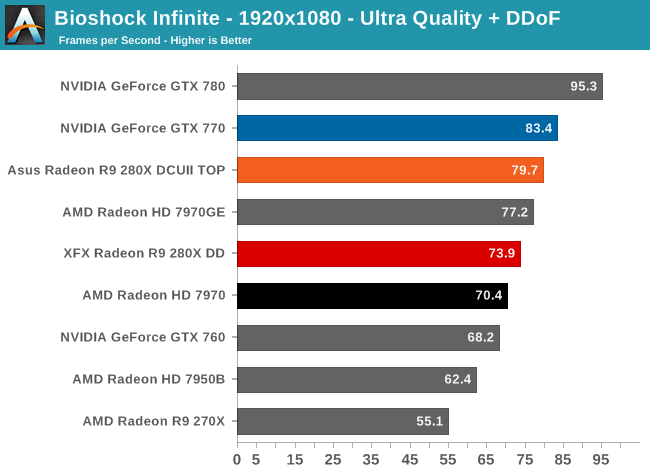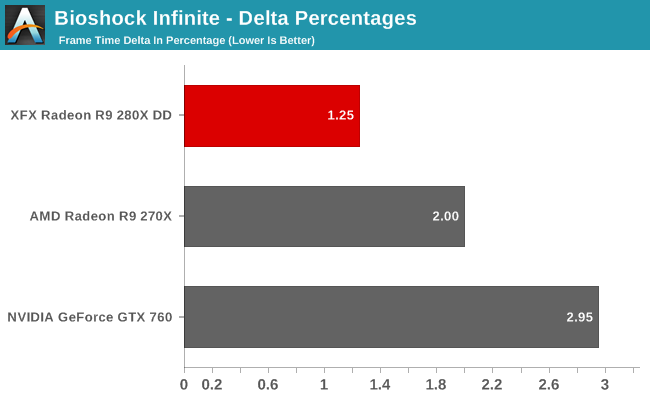The Radeon R9 280X Review: Feat. Asus & XFX - Meet The Radeon 200 Series
by Ryan Smith on October 8, 2013 12:01 AM ESTBioshock: Infinite
Bioshock Infinite is Irrational Games’ latest entry in the Bioshock franchise. Though it’s based on Unreal Engine 3 – making it our obligatory UE3 game – Irrational had added a number of effects that make the game rather GPU-intensive on its highest settings. As an added bonus it includes a built-in benchmark composed of several scenes, a rarity for UE3 engine games, so we can easily get a good representation of what Bioshock’s performance is like.



Bioshock has always favored NVIDIA GPUs to some extent, and of course this will carry over to 280X. The 280X is still well clear of the cheaper GTX 760, but it’s not going to be catching the GTX 770 any time soon. Nor will the factory overclock of the Asus card close that gap, though it will at least get the performance of a 280X card above 50fps.

Looking at our FCAT data quickly, the data is unremarkable. Bioshock has more variance than most other games, but even so everyone is able to stay under 3%.










151 Comments
View All Comments
Dribble - Tuesday, October 8, 2013 - link
Didn't you read the article - it is a 7970GE give or take a little on clocks (depending on what 280 you buy). The only new card is the 290 all the others are the same cards you could already buy. The news is lower prices, although as 7970's were already at lower prices then AMD recommended not sure how much real change there will be.The biggest downer for AMD fans will be the end of the 7950, which was always the price/performance king.
Da W - Tuesday, October 8, 2013 - link
It's gonna be the R9 280 (no X).I might just go and buy two 7950 right now. I'm not sure a single Hawaii priced near a 780 is worth it, crossfire issues notwithstanding.
Very disappointing. Specs I saw floating here and there pointed to 270X being more like a Tahiti XL.
zeock9 - Tuesday, October 8, 2013 - link
Didn't you read my comment - 7970GE can already be had for the same price, so it's the same card for more money because 280X doesn't come with the Never Settle bundle.Trying to charge more buck for less bang just because it has a new name is a effing shame of a business practice.
ninjaquick - Tuesday, October 8, 2013 - link
What do you expect? AMD is not releasing a new architecture this time around. They have a very efficient design in GCN, they will not go changing it. Mark my words, the 370X is going to be a die shrunk 7970 GHz, and the 460X is going to be the same, or just a 'rebadged' 370X. AMD's GCN is a bottom-up modular design, not a top-down big chip first design.HisDivineOrder - Tuesday, October 8, 2013 - link
Mantle is going to require they not stray too far from GCN and the way the cards are currently laid out. Otherwise, you'd have games suddenly having cards they're "Mantle compatible" with and cards they aren't.You won't see huge shifts in how the GCN is laid out post GCN 1.1 if they want to keep low level access working smoothly for the foreseeable future. Then again, perhaps they'll do the shift and just shift back to supporting their high level (drivers) instead once Mantle craters on impact because nVidia and Intel start throwing their money around...
Either way, I'm pretty sure Mantle is a cost-cutting tool to help de-emphasize driver development on the consumer side and help keep up with performance gains by aggressive nVidia and intel release cycles that AMD doesn't have the money to fight.
roastmeat - Tuesday, July 21, 2015 - link
Ha, well what do you knowThe 370 is a rebadge
chizow - Tuesday, October 8, 2013 - link
"AMD has been very explicit in not calling these rebadges, and technically they are correct, but all of these products should be very familiar to our regular readers."So how are these not rebadges/rebrands again and how is it technically correct to not call them rebadges? I just find it funny that AMD was so explicit about not calling them as such, I mean it's clear both parties have a history of rebranding, but let's call a spade a spade here.
Nvidia was pounded by AMD fanboys and the press alike for it's rebranding of G92, but any single iteration from G92 certainly had more changes than the non-existent changes we see with this R7/R9 rebrand stack.
Ryan Smith - Tuesday, October 8, 2013 - link
A rebadge would be something like the 5770 to 6770. Same card, same clocks, same TDP. These are new SKUs, based on existing GPUs, under a new name.chizow - Tuesday, October 8, 2013 - link
lol I guess we have some revisionist history that needs to be written then. Not blaming you of course for public perception, just saying, these were not the standards in G92's day as it easily cleared this very low standard of different clockspeeds/TDP/card design, as every single G92 incarnation surpassed these requirements.In any case, I did appreciate the in-depth coverage of Mantle, possible benefits, repercussions, downsides. Excellent coverage and commentary on all angles, as usual. Look forward to more detail about it in the future.
Gigaplex - Tuesday, October 8, 2013 - link
If the silicon isn't any different, the only distinction is in the board itself and the firmware setting the speeds etc, then it's a rebadge in my books. Nothing stopping OEMs from changing these around, and this does in fact happen with the OC cards. What is the difference between a rebadged chip with an OC vs one of these?